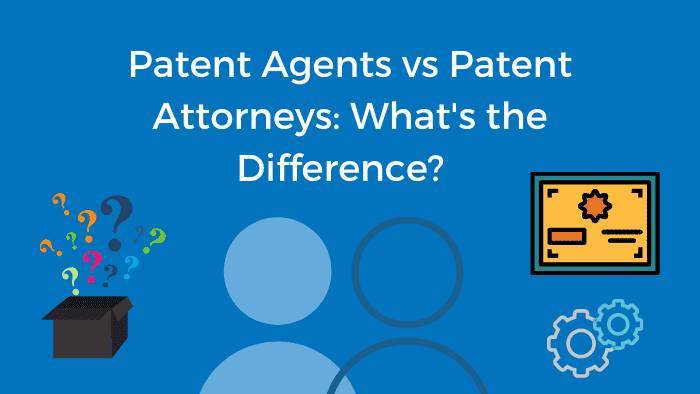Let me just start this article by saying “I love you” to any of you patent agents that are reading this. This article is not meant to be a jab at you in any way, nor will I intentionally disparage you in any way. In fact, we have patent agents on our Bold team because they write and prosecute patents just as well or better than some of our attorneys!
This question keeps coming up, so I thought I’d lay all the differences out, and give some dialogue to help inventors understand why the two roles exist, and why I think both are good for inventors, and in many cases, they can work together quite well.
Here are the major areas worthy of discussion:
- Educational Background
- Confidentiality
- Duties & Ethical Obligations
- State and Federal Rules
- Patentability Opinion
- Patent Application Drafting
- Patent Office Actions
- Patent Litigation
- Patent Monetization
There are a lot of differences between what a Patent Attorney can do, and what a Patent Agent can do. However, for this article, I’ll focus on how the two roles are different in terms of how each can help inventors.
Education Background
To become a Patent Attorney, the minimum requirements is:
- High-School degree
- 4-year Undergraduate Bachelor of Science degree*
- 3-year Law School Juris Doctorate degree**
- Pass a Uniform/State Bar Exam***
- Passing the USPTO Patent Bar Exam
* Some patent attorneys have graduate degrees (e.g. Masters or PhD studies). There are also ways to qualify for the Patent Bar without a degree, but by showing an equivalent level of coursework.
** Some patent attorneys have advanced legal degrees called LLMs on top of the Juris Doctorate
*** Many patent attorneys are licensed to practice in more than one state. All state bars also have a character/fitness component as well, and requirements to maintain the license through continuing legal education (CLE) courses yearly.
Without going into too much detail, I’ve found a good resource that shows what a core curriculum looks like for a juris doctorate degree program:
Year 1: Contracts, Torts, Civil Procedure, Property, Criminal, Legal Writing
Year 2: Legal Writing II, Constitutional, Evidence, Intellectual Property, Patent Law*
Year 3: International Law, Ethics, Clinic Courses, IP Licensing*, Patent Lab*
*These are example elective courses
Patent Agents aren’t required to go to law school (see above), nor take the state bar exam; therefore, they may not give legal advice.
To become a Patent Agent, the minimum requirements is:
- High-School degree
- 4-year Undergraduate Bachelor of Science degree*
- Passing the USPTO Patent Bar Exam
* Many patent agents have graduate degrees (e.g. Masters or PhD studies). There are also ways to qualify for the Patent Bar without a degree, but by showing an equivalent level of coursework.
Let’s take just a minute to pause and appreciate the gravity of the USPTO Patent Bar Exam. The USPTO publishes statistics on bar exam pass rates at this link here https://www.uspto.gov/learning-and-resources/patent-and-trademark-practitioners/registration-exam-results-and-statistics
For the past 5 years…pass rates have actually been BELOW 50%!
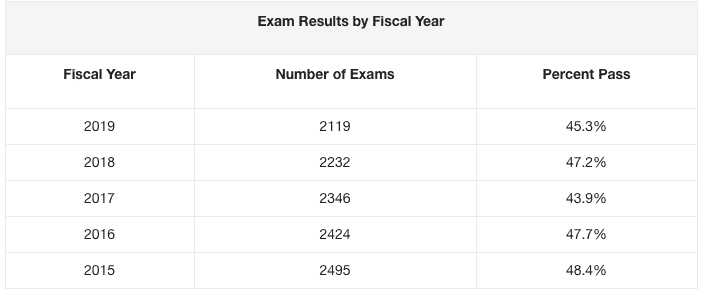
The worst year was in 2017, a paltry 43% of test-takers passed. YIKES! The people taking this exam are not slouches…they are college graduates in a science field! Let’s just say, these people know how to study and take exams.
Did I mention that this exam (at least when I took it) is OPEN BOOK! Haha. The amount of information that has to be known is massive. Just take a look at the USPTO’s Manual for Patent Examination and Procedure (MPEP) here: https://www.uspto.gov/web/offices/pac/mpep/index.html. Here is the full list of chapters/information there:
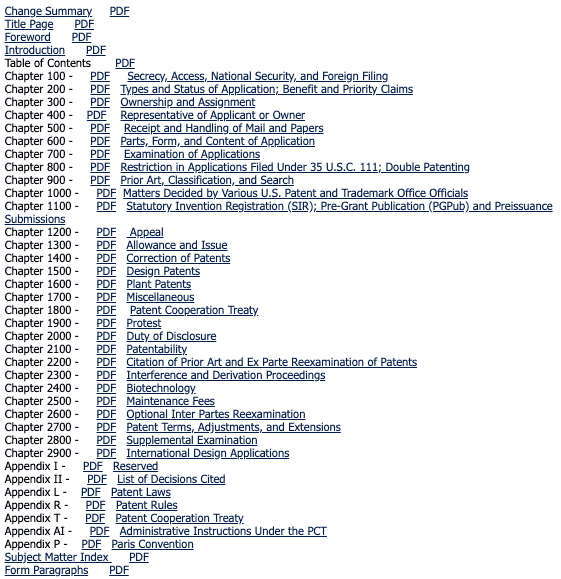
The patent bar exam assures knowledge within the rules of how to get a patent issued, but it doesn’t teach how to assure a patent will stand up in court in front of a judge or jury if it were to be tested.
So, an understanding of the law is what a Patent Attorney can bring to the table from an education standpoint. They have the education/training to know how patents are litigated, because they can read/understand a judge’s opinions more fully in order to relay the significance to their inventor clients, or form arguments to the USPTO examiner or Patent Trial and Appeal Board.
While I’m not certain there are any statistics on this, from my experience, I’ve found that there are more patent agents with higher graduate level technical degrees than patent attorneys. In other words, patent agents tend to have Masters level or PhD level degrees in their technical field, whereas most patent attorneys have just a 4-year degree.
Confidentiality
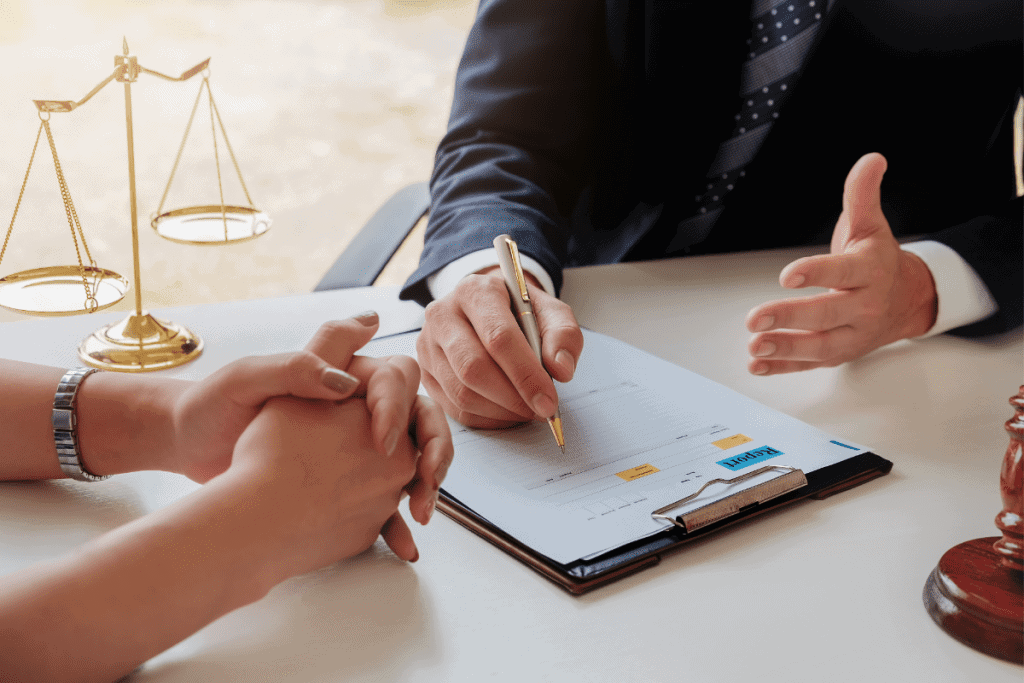
Taking a look first at what each Patent Attorneys and Patent Agents have in common in their education backgrounds is that they each have studied, taken, and passed the USPTO Patent Bar Exam (and you saw how grueling it is).
The rule both Patent Attorneys and Patent Agents are required to follow regarding confidentiality is in its complete form below:
================================================================
37 CFR § 11.106 Confidentiality of information.
(a) A practitioner shall not reveal information relating to the representation of a client unless the client gives informed consent, the disclosure is impliedly authorized in order to carry out the representation, the disclosure is permitted by paragraph (b) of this section, or the disclosure is required by paragraph (c) of this section.
(b) A practitioner may reveal information relating to the representation of a client to the extent the practitioner reasonably believes necessary:
(1) To prevent reasonably certain death or substantial bodily harm;
(2) To prevent the client from engaging in inequitable conduct before the Office or from committing a crime or fraud that is reasonably certain to result in substantial injury to the financial interests or property of another and in furtherance of which the client has used or is using the practitioner’s services;
(3) To prevent, mitigate or rectify substantial injury to the financial interests or property of another that is reasonably certain to result or has resulted from the client’s commission of a crime, fraud, or inequitable conduct before the Office in furtherance of which the client has used the practitioner’s services;
(4) To secure legal advice about the practitioner’s compliance with the USPTO Rules of Professional Conduct;
(5) To establish a claim or defense on behalf of the practitioner in a controversy between the practitioner and the client, to establish a defense to a criminal charge or civil claim against the practitioner based upon conduct in which the client was involved, or to respond to allegations in any proceeding concerning the practitioner’s representation of the client; or
(6) To comply with other law or a court order.
(c) A practitioner shall disclose to the Office information necessary to comply with applicable duty of disclosure provisions.
================================================================
Under paragraph (a), the “practitioner” (which is either a Patent Attorney or Agent) is only allowed to disclose confidential information when there is informed consent. This consent is usually achieved via written acknowledgement, and more conservatively when signed off by the inventor/client.
The exceptions to the rule under (a) are listed under (b), which for the most part make good sense. In summary, if keeping information secret will harm (physically or financially) another party and the likelihood of that harm is high enough, then disclosure is permissible.
And thank goodness for (b)(4)! There are SO many situations that are just strange, and it’s very nice being able to share our situation with the USPTO to check and see if we’re handling the confidential information properly. The Office of Enrollment and Discipline (OED) can take these calls and are usually quite helpful in assuring we take the right steps (see ethical discussion below)
Now, as a licensed Patent Attorney, there are MORE layers of confidentiality at play. Specifically, the State Law Ethical rules in which the attorney (or law firm) serves clients in. Our firm’s headquarters is in Washington state, and that is where I am licensed as an Attorney. Therefore, I am personally obligated to abide by the Washington State Ethical Rules for attorneys practicing in that state.
Here are the Washington Rules of Professional Conduct (RPCs) pertaining to client confidentiality:
==================================================================
RPC 1.6
CONFIDENTIALITY OF INFORMATION
(a) A lawyer shall not reveal information relating to the representation of a client unless the client gives informed consent, the disclosure is impliedly authorized in order to carry out the representation or the disclosure is permitted by paragraph (b).
(b) A lawyer to the extent the lawyer reasonably believes necessary:
(1) shall reveal information relating to the representation of a client to prevent reasonably certain death or substantial bodily harm;
(2) may reveal information relating to the representation of a client to prevent the client from committing a crime;
(3) may reveal information relating to the representation of a client to prevent, mitigate or rectify substantial injury to the financial interests or property of another that is reasonably certain to result or has resulted from the client’s commission of a crime or fraud in furtherance of which the client has used the lawyer’s services;
(4) may reveal information relating to the representation of a client to secure legal advice about the lawyer’s compliance with these Rules;
(5) may reveal information relating to the representation of a client to establish a claim or defense on behalf of the lawyer in a controversy between the lawyer and the client, to establish a defense to a criminal charge or civil claim against the lawyer based upon conduct in which the client was involved, or to respond to allegations in any proceeding concerning the lawyer’s representation of the client;
(6) may reveal information relating to the representation of a client to comply with a court order;
(7) may reveal information relating to the representation to detect and resolve conflicts of interest arising from the lawyer’s change of employment or from changes in the composition or ownership of a firm, but only if the revealed information would not compromise the attorney-client privilege or otherwise prejudice the client; or
(8) may reveal information relating to the representation of a client to inform a tribunal about any client’s breach of fiduciary responsibility when the client is serving as a court appointed fiduciary such as a guardian, personal representative, or receiver.
(c) A lawyer shall make reasonable efforts to prevent the inadvertent or unauthorized disclosure of, or unauthorized access to, information relating to the representation of a client.
==================================================================
So, you can see there are a LOT of overlaps and commonalities (thank goodness!), but also a few differences. You can see in (b)(7) this idea that some information may need to be disclosed in order to find out if there are any conflicts of interest between prospective clients – and this was not discussed in the USPTO’s version. Also, in (c) above, the idea that the lawyer must make “reasonable efforts” to prevent information theft, puts the onus on the attorney to maintain up-to-date security over documents/files.
Lastly, I wanted to mention that because may law firms (like ours) practice in several jurisdictions, looking at the American Bar Association (ABA) model rules for confidentiality is helpful, as ALL (California was the big holdout – who just finally adopted as of November, 2018) state bars have adopted them.
Here is the ABA rule on confidentiality:
==================================================================
Rule 1.6: Confidentiality of Information
(a) A lawyer shall not reveal information relating to the representation of a client unless the client gives informed consent, the disclosure is impliedly authorized in order to carry out the representation or the disclosure is permitted by paragraph (b).
(b) A lawyer may reveal information relating to the representation of a client to the extent the lawyer reasonably believes necessary:
(1) to prevent reasonably certain death or substantial bodily harm;
(2) to prevent the client from committing a crime or fraud that is reasonably certain to result in substantial injury to the financial interests or property of another and in furtherance of which the client has used or is using the lawyer’s services;
==================================================================
As you can see, the rule on confidentiality by the ABA is much more basic, because it is attempting to be universal (lowest common denominator). As you can see the USPTO’s and Washington’s version are more lenient, and allow more opportunities to disclose information.
Duties & Ethical Obligations
Similar to the discussion above, both Patent Agents and Attorneys are held to the same standard by the USPTO rules with respect to Inventor-Clients. These rules are published under Title 37 of the Code of Federal Regulations under Part/Chapter 11 (also called subchapter D).
I’ve listed the entire set of rules (as published by Cornell’s Legal Information Institute), with links and have some written discussion below:
==================================================================
- Client-Practitioner Relationship (§§ 11.101 – 11.119-11.200)
- § 11.101 Competence.
- § 11.102 Scope of representation and allocation of authority between client and practitioner.
- § 11.103 Diligence.
- § 11.104 Communication.
- § 11.105 Fees.
- § 11.106 Confidentiality of information.
- § 11.107 Conflict of interest; Current clients.
- § 11.108 Conflict of interest; Current clients; Specific rules.
- § 11.109 Duties to former clients.
- § 11.110 Imputation of conflicts of interest; General rule.
- § 11.111 Former or current Federal Government employees.
- § 11.112 Former judge, arbitrator, mediator or other third-party neutral.
- § 11.113 Organization as client.
- § 11.114 Client with diminished capacity.
- § 11.115 Safekeeping property.
- § 11.116 Declining or terminating representation.
- § 11.117 Sale of law practice.
- § 11.118 Duties to prospective client.
- §§ 11.119-11.200 [Reserved]
- Counselor (§§ 11.201 – 11.205-11.300)
- § 11.201 Advisor.
- § 11.202 [Reserved]
- § 11.203 Evaluation for use by third persons.
- § 11.204 Practitioner serving as third-party neutral.
- §§ 11.205-11.300 [Reserved]
- Advocate (§§ 11.301 – 11.310-11.400)
- § 11.301 Meritorious claims and contentions.
- § 11.302 Expediting proceedings.
- § 11.303 Candor toward the tribunal.
- § 11.304 Fairness to opposing party and counsel.
- § 11.305 Impartiality and decorum of the tribunal.
- § 11.306 Trial publicity.
- § 11.307 Practitioner as witness.
- § 11.308 [Reserved]
- § 11.309 Advocate in nonadjudicative proceedings.
- §§ 11.310-11.400 [Reserved]
- Transactions With Persons Other Than Clients (§§ 11.401 – 11.405-11.500)
- Law Firms and Associations (§§ 11.501 – 11.508-11.700)
- § 11.501 Responsibilities of partners, managers, and supervisory practitioners.
- § 11.502 Responsibilities of a subordinate practitioner.
- § 11.503 Responsibilities regarding non-practitioner assistance.
- § 11.504 Professional independence of a practitioner.
- § 11.505 Unauthorized practice of law.
- § 11.506 Restrictions on right to practice.
- § 11.507 Responsibilities regarding law-related services.
- §§ 11.508-11.700 [Reserved]
- Information About Legal Services (§§ 11.701 – 11.706-11.800)
- Maintaining the Integrity of the Profession (§§ 11.801 – 11.901)
==================================================================
Just for comparison purposes, I’ve copied below the table of contents of the ABA Ethical rules below:
==================================================================
Rules
Rule 1.0 Terminology
Client-Lawyer Relationship
Rule 1.1 Competence
Rule 1.2 Scope of Representation and Allocation of Authority Between Client and Lawyer
Rule 1.3 Diligence
Rule 1.4 Communications
Rule 1.5 Fees
Rule 1.6 Confidentiality of Information
Rule 1.7 Conflict of Interest: Current Clients
Rule 1.8 Conflict of Interest: Current Clients: Specific Rules
Rule 1.9 Duties to Former Clients
Rule 1.10 Imputation of Conflicts of Interest: General Rule
Rule 1.11 Special Conflicts of Interest for Former and Current Government Officers and Employees
Rule 1.12 Former Judge, Arbitrator, Mediator or Other Third-Party Neutral
Rule 1.13 Organization as Client
Rule 1.14 Client with Diminished Capacity
Rule 1.15 Safekeeping Property
Rule 1.16 Declining or Terminating Representation
Rule 1.17 Sale of Law Practice
Rule 1.18 Duties to Prospective Client
Counselor
Rule 2.1 Advisor
Rule 2.2 (Deleted)
Rule 2.3 Evaluation for Use by Third Persons
Rule 2.4 Lawyer Serving as Third-Party Neutral
Advocate
Rule 3.1 Meritorious Claims and Contentions
Rule 3.2 Expediting Litigation
Rule 3.3 Candor toward the Tribunal
Rule 3.4 Fairness to Opposing Party and Counsel
Rule 3.5 Impartiality and Decorum of the Tribunal
Rule 3.6 Trial Publicity
Rule 3.7 Lawyer as Witness
Rule 3.8 Special Responsibilities of a Prosecutor
Rule 3.9 Advocate in Nonadjudicative Proceedings
Transactions with Persons Other Than Clients
Rule 4.1 Truthfulness in Statements to Others
Rule 4.2 Communication with Person Represented by Counsel
Rule 4.3 Dealing with Unrepresented Person
Rule 4.4 Respect for Rights of Third Persons
Law Firms and Associations
Rule 5.1 Responsibilities of a Partner or Supervisory Lawyer
Rule 5.2 Responsibilities of a Subordinate Lawyer
Rule 5.3 Responsibilities Regarding Nonlawyer Assistance
Rule 5.4 Professional Independence of a Lawyer
Rule 5.5 Unauthorized Practice of Law; Multijurisdictional Practice of Law
Rule 5.6 Restrictions on Rights to Practice
Rule 5.7 Responsibilities Regarding Law-related Services
Public Service
Rule 6.1 Voluntary Pro Bono Publico Service
Rule 6.2 Accepting Appointments
Rule 6.3 Membership in Legal Services Organization
Rule 6.4 Law Reform Activities Affecting Client Interests
Rule 6.5 Nonprofit and Court Annexed Limited Legal Services Programs
Information About Legal Services
Rule 7.1 Communication Concerning a Lawyer’s Services
Rule 7.2 Communications Concerning a Lawyer’s Services: Specific Rules
Rule 7.3 Solicitation of Clients
Rule 7.4 (Deleted)
Rule 7.5 (Deleted)
Rule 7.6 Political Contributions to Obtain Legal Engagements or Appointments by Judges
Maintaining the Integrity of the Profession
Rule 8.1 Bar Admission and Disciplinary Matters
Rule 8.2 Judicial and Legal Officials
Rule 8.3 Reporting Professional Misconduct
Rule 8.4 Misconduct
Rule 8.5 Disciplinary Authority; Choice of Law
==================================================================
Just taking a little snapshot on the very first rule “Competence” , let’s look at the difference in wording:
ABA Rules (For Patent Attorneys)
A lawyer shall provide competent representation to a client. Competent representation requires the legal knowledge, skill, thoroughness and preparation reasonably necessary for the representation.
USPTO Rules (For Both)
A practitioner shall provide competent representation to a client. Competent representation requires the legal, scientific, and technical knowledge, skill, thoroughness and preparation reasonably necessary for the representation.
So, in this case, for “competence”, you can see that the USPTO requires more than the legal ABA rule would, so there is no difference between obligations here.
In truth, it is VERY hard to find substantial differences between the ethical obligations of both Attorneys and Patent Agents. Both are held to very high standards. For Patent Agents, the rules are clearly written in one location (37 CFR Section 11), but for Attorneys, they have to assure they are meeting all rules of the states they practice in as well as the USPTO rules.
State & Federal Rules
There are NO state rules governing the representation of Patent Agents, the only rules are found in 37 CFR Part 11 (shown above).
Patent Attorneys are governed by the state professional responsibility rules AND the federal rules under 37 CFR Part 11.
These differences exist only in the instance where the Patent Agent or Patent Attorney are practicing independently. In most situations, Patent Agents are employees within a larger law firm. Therefore, the entire law firm will be treated under the dual-obligation to assure compliance with BOTH state and federal professional/ethical standards.
Patentability Opinions
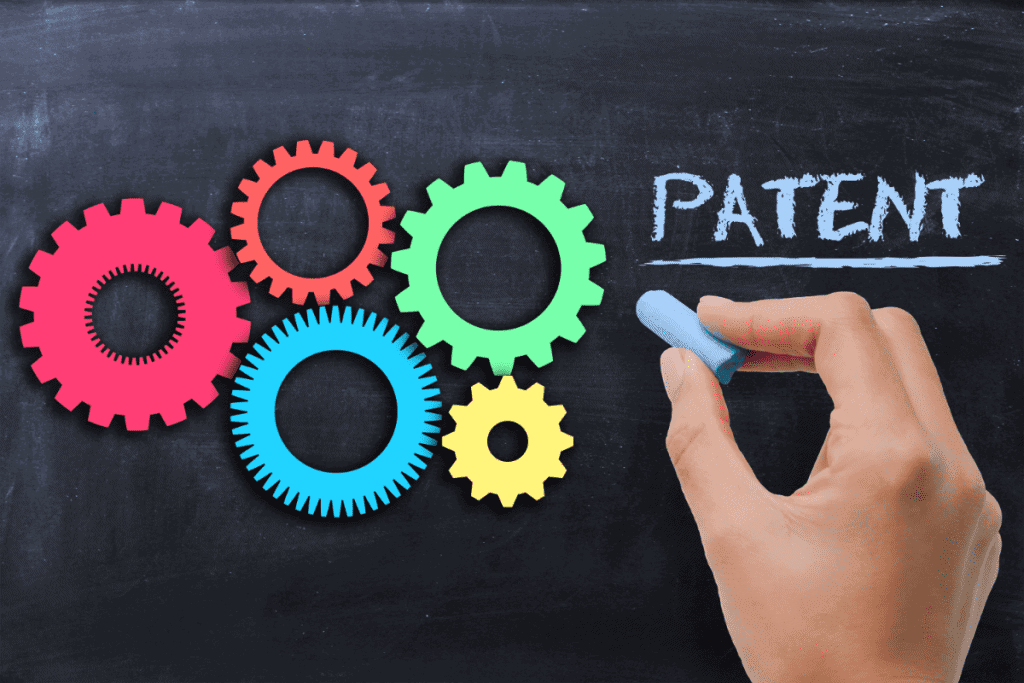
Now that we’ve laid the groundwork for rules that Patent Agents and Attorneys must follow, we can now talk about the WORK they each can do for inventors!
I preach about conducting a thorough patent search and getting an opinion on the results as a CORNERSTONE part of the patent process. I’ve written a detailed blog article about it, published a patent searching video, and discussed patent searching extensively on our website.
The patent search itself is where we want to help our inventors confirm (or deny) the novelty and nonobviousness of their invention.
The research required to find patent documents, non-patent literature, references, or prior art is common among both Patent Agents and Patent Attorneys – both can perform this function.
Quite often, this research phase is actually outsourced to patent search specialists. There are many reputable companies (in the US and abroad – specifically India) that do a great job pulling many databases together to evaluate whether any aspect of the proposed invention is found in the prior art.
The quality of the search is important, but what really matters is the analysis and opinion that comes with the “patentability opinion”.
There are three major aspects of the patentability opinion:
- Eligibility
- Novelty
- Nonobviousness
Patent Agents and Attorneys can both deliver analysis and opinions on the three areas above, however, there is a key difference in the kind of direction and advice that can be given:
- Patent Agents can only give opinions on likliness of a specific invention to be accepted or rejected by a USPTO examiner;
- Attorneys can give analysis/opinions on the likelihood of acceptance/rejection AND give legal advice on what legal course of action they should pursue next. Which could be to proceed with a patent application (taking everything into consideration), start a company, raise money, test the invention, etc.
A good way to think of this is that a patent agent can help you just as well as a Patent Attorney can when it comes to the mechanics and ins/outs of patent prosecution, they just have to stop short when it comes to recommending courses of action to take related to the patent. Such as considerations related to how to enter into contracts (licensing, assignment, sale, etc.), or forming a business entity, employment law, or litigation.
Patent Application Drafting
This part of the patent process is nearly identical from Patent Agent to Attorney. The core components of a nonprovisional patent application are:
- Written Description
- Claims
- Figures
The written description portion of the application is where the invention is described in detail – and this really can be done by both Agents and Attorneys without much difference at all. The one thing to note here is that Patent Attorneys will generally have a more long-term view to avoid future litigation even in the written description portion. Every so often a Federal Circuit or Supreme Court will issue precedential opinons that touch on how certain aspects of the invention writing can affect the rights. For example, when writing about your invention and talking about competitors or other references, you don’t want to state that certain existing technology is “prior art”, even if it is. It will act as an admission, and you may actually not be able to later argue that you distinguish from it, in later prosecution.
Claim writing is also very similar between Agents and Attorneys. So, when it comes to the mechanics and understanding of the types of claims, structure, and assuring antecedent basis for each claim element in the specification – both Agents and Attorneys are in their element here. The one differentiator again is that Patent Attorneys have knowledge of and can more easily implement changes to the law and apply it to their claim drafting style.
For example, if the Federal Circuit recently allowed (or decided not to invalidate) a claim set covering a computer-implemented invention, and they seemed to really like how the element of “voice transmitter” was in the claim – that knowledge can be imported into their client’s claims as well.
Figures, for the most part, are done by 3rd party patent drafters – so these will be virtually identical as between Agents and Attorneys.
Patent Office Actions
Just like the written description/specification – office action responses are for the most part going to be handled in very much the same way no matter if an Agent or Attorney is at the helm.
Attorneys may be able to bring more to the table when it comes to the softer skills of negotiating, which can happen in an examiner interview, or through subtle legal argument when both sides have dug-in and are not budging.
In addition, Patent Attorneys will be better equipped to help an inventor/applicant appeal an examiner’s decision to both the Patent Trial and Appeal Board and the Federal District Court of Appeals or Supreme Court (which an Attorney must attend). Note, these appeals are quite rare – but its good to be working with someone that can help you take the case all the way to the Supreme Court (if needs be).
Patent Litigation
This topic is heavily in favor of Attorneys, as you might expect. Agents are not members of the bar, so they cannot represent clients in court at all. That said, they can help support litigation by being expert witnesses, or can provide Patent Attorneys with detailed claim charts, or specific exhibits on prosecution detail from the USPTO.
Litigation starts by performing initial inquiries, and Attorneys are the best suited to provide answers to the questions inventors and owners of patents have:
- Is my patent still valid/enforceable?
- Are they infringing on my patent?
- How do I stop infringers from ripping me off?
- If I sell this product, will I be infringing anyone’s patents?
These core questions can be answered only by a Patent Attorney’s legal opinion based on facts and application to the everchanging law. The types of opinions Patent Attorneys provide in support of future litigation are:
- Validity Opinions
- Infringement Opinions or Non-Infringement Opinions
- Landscape Opinions
- Freedom To Operate Opinions
- Claim Charts (comparing patent claims to infringing product)
While a Patent Agent could likely provide valuable insight into each of these areas, including detailed analysis, they cannot provide a legal opinion or give a recommendation for a course of action to their client on these topics.
Patent Monetization
To get a return on your investment, you will need to ENFORCE your rights to the invention. Enforcement of your patent rights comes through Litigation (See above). Therefore, patent Attorneys have a distinct advantage in this area over Agents.
Typical strategies for making money with your patent include, of course, just making/selling your invention and making sure no one else infringes your patents (this is called enforcement). To do this right, you have to make sure you keep your eye on the market to watch out for any patent infringement.
As was mentioned above in the “Patent Litigation” section, most of these strategies require the assistance of a Patent Attorney in order to give you legal opinions as well as proper legal representation for enforcement.
There are some proactive strategies that include seeking a buyer or licensee for your patent can also be quite lucrative, but may require more salesmanship.
It should be noted that in order to license your patent rights, the negotiation, drafting of a license agreement must all be handled by a Patent Attorney, as it is the practice of law.
Conclusion
There you have it! The complete guide to patent agent vs patent attorney and their roles.
Let’s recap the information we covered about patent agents.
Table of Contents
- Education Background
- Confidentiality
- Duties & Ethical Obligations
- Rules
- Client-Lawyer Relationship
- Counselor
- Advocate
- Transactions with Persons Other Than Clients
- Law Firms and Associations
- Public Service
- Information About Legal Services
- Maintaining the Integrity of the Profession
- State & Federal Rules
- Patentability Opinions
- Patent Office Actions
- Patent Litigation
- Patent Monetization
After reading this guide be sure to book a free consultation with a patent attorney today!
